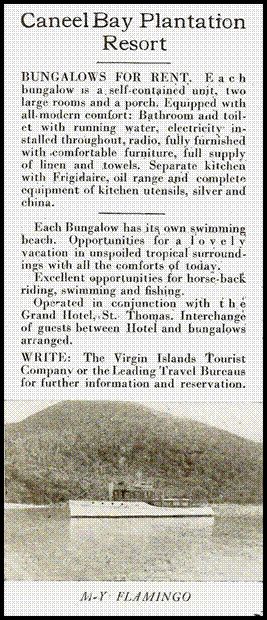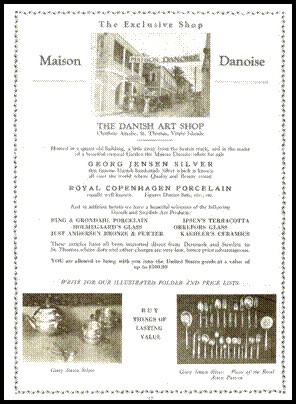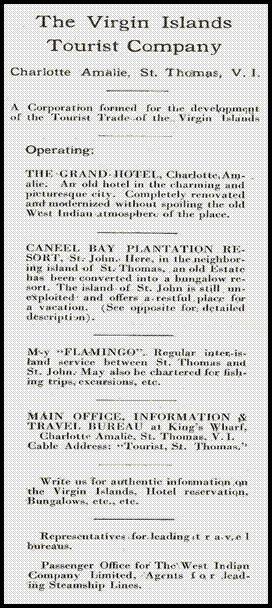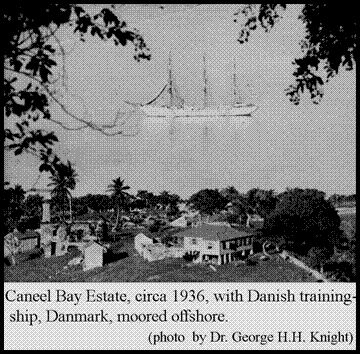Caneel Bay Estate Before Laurance Rockefeller
(Editors Note: Last Fall, while at the Rockefeller Archive Center in Sleepy Hollow, New York, my wife and I ran across the following April 5, 1956 memo from Mr. Hjalmar Bang, regarding his early association with the Caneel Bay Estate.)
(Published by permission of Rockefeller Archive Center. Ads are from a VI Tourism magazine produced by the government.)

“In connection with my contact with the Caneel Bay Estate in St. John, Virgin Islands, I might give you the following data:
I came to St. Thomas, V.I., in the year 1919, two years after the transfer of the Islands from Denmark to the United States, as an employee of the West Indian Company, Ltd., a subsidiary of the East Asiatic Co., Ltd. of Copenhagen, for which concern I was working. The West Indian Company, Ltd., owned harbour facilities and an electric power plant in St. Thomas, and engaged in various kinds of shipping and trading business connected therewith.
In 1934, a small enterprise, by name Maison Danoise, was started in St. Thomas for the purpose of introducing and selling Danish silver, porcelain, and other Scandinavian objects of art to the tourists, who were just then beginning to find their way to St. Thomas in increasing numbers. This little enterprise soon became a considerable success, so much so that it gave rise, directly, to an increasing number of calls of tourist ships of the prominent steamship lines.
In 1935, Caneel Bay, St. John, was bought by the Virgin Islands Tourist Company, which was formed by friends of the West Indian Co. to take over the Maison Danoise and the Caneel Bay Estates. The inspiration to this step was given by Mr. Robert Herrick, the writer, a man of high principles and intellect, and former professor at the University of Chicago, who had accepted the appointment of Government Secretary, to the Virgin Islands, at the specific request of his former pupil, the then, Secretary of Interior Harold Ikes. Mr. Herrick, I should like it to be noted, possessed vision, and a deep affection for the Virgin Islands and many remnants of the Colonial period protected against indiscriminate exploitation. No better fate could therefore have befallen Caneel Bay Estate than to be taken into the protective custody of the Rockefeller Foundation.*

Caneel Bay, an old deserted sugar estate of about 550 acres, overgrown with tropical vegetation, was in ill repute owing to the prevalence of mosquitoes and sand flies. Work was started immediately, with the profits from the silver shop, to clear some of the brush and to drain the lagoon, the breeding place for the insects. At the same time construction was begun on two substantial cottages, soon afterwards to be increased to six.
The insects were successfully eliminated, and the Caneel Bay resort very quickly became known to the extent that a waiting list existed at the time the United States entered World War II.

During the War years Caneel Bay was used for purposes other than in connection with tourism, and about 1946, two years after the termination of my association with the East Asiatic and West Indian Company, the Caneel Bay Estate was sold, for the first time, at its book value, about $80,000, to a firm in Puerto Rico…”

*As pointed out by the Executive Director of the Rockefeller Archive Center, Mr. Bang was mistaken about the role of the Rockefeller Foundation. In fact, it was a private act of Laurance S. Rockefeller, who initially turned the property over to Jackson Hole Preserve, Inc., which, in turn, gave a portion to the U.S. government. Ultimately, the remaining Caneel Bay property will be turned over to the Department of the Interior.
[Caneel Bay (AKA Little Caneel Bay)][Rockefeller, Laurance]
